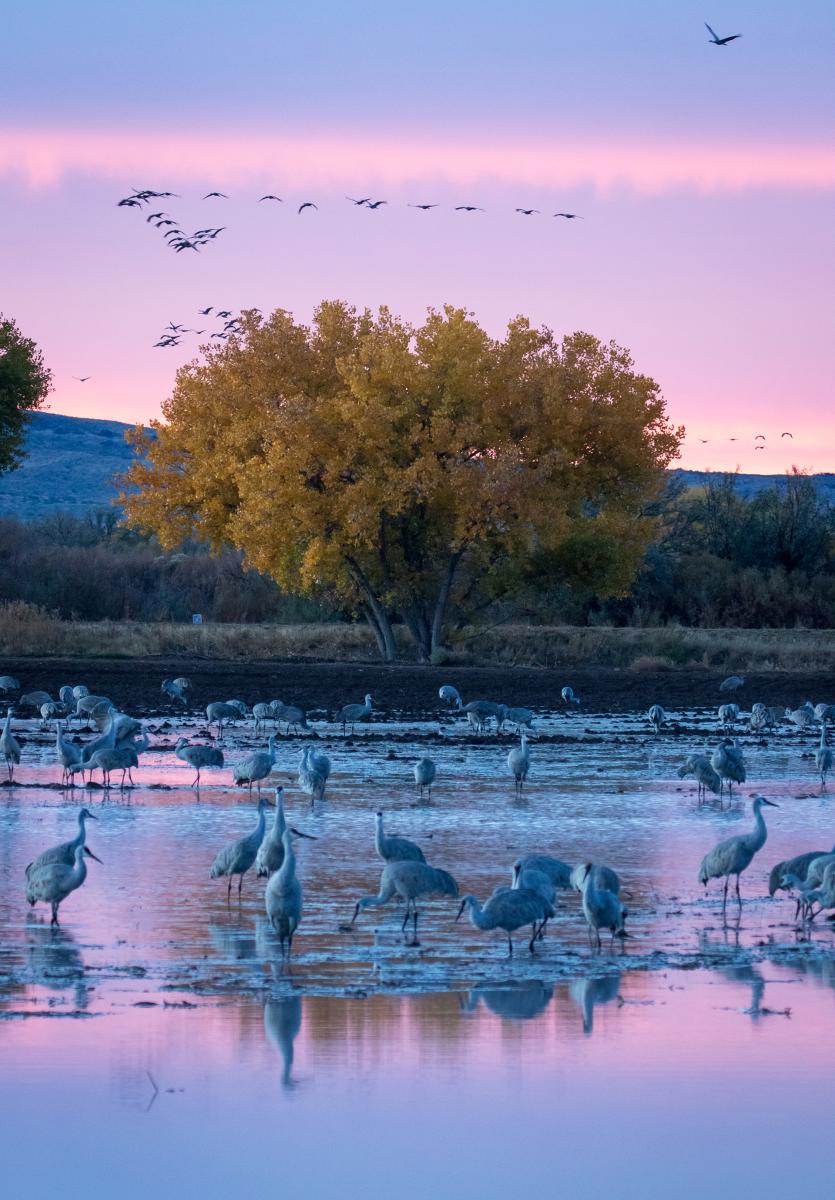Bitter Lake provides a wintering habitat for migrating birds.
NEW MEXICO IS THE PERFECT STORM for birders,” says Jon Hayes, executive director of Audubon Southwest. Home to more than 500 species, New Mexico boasts environments ranging from high-elevation habitats to riparian forests, and desert scrub to rocky canyons. In a state bursting with awesome birding locations and opportunities, these five are must-visits for every serious birder.
Bitter Lake National Wildlife Refuge
In southeastern New Mexico, where the southern Great Plains and the Chihuahuan Desert bump up against each another, the Pecos River wends its way through the landscape, creating a tremendously rich, biologically significant series of lakes and wetlands that stretch into both ecosystems. Bitter Lake was established in 1937 to provide wintering habitat for migrating birds. Some of New Mexico’s most threatened species, including the least tern and the snowy plover, shelter in the refuge. “This is one of the best locations in the state to find white-rumped sandpipers in late spring,” says Godfrey.

Sandhill cranes are among the joys of Bosque del Apache.
Bosque del Apache National Wildlife Refuge
Probably New Mexico’s premier birding location, this 57,331-acre mix of riparian forests, wetlands, lakes, and Chihuahuan Desert near Socorro sports an array of birds throughout the year. The high point, however, comes when sandhill cranes, snow geese, and other migrating aquatic birds congregate in the 70-year-old refuge. “In the winter, thousands of snow geese and sandhill cranes take off from large, shallow ponds in a dramatic morning ascent, and then return in waves later in the afternoon, with both events providing exceptional photography opportunities,” says Steve Knox, a retired physicist and Christmas Bird Count leader.
Gila National Forest
In the southwest, the Gila National Forest overlaps a number of ecosystems, creating an environment for high-diversity, high-elevation birding where you’ll find spotted owls, acorn woodpeckers, Mexican jays, Cordilleran flycatchers, vireos, and a host of warblers. High-elevation bodies of water like Lake Roberts are also a great place to catch sight of aquatic birds. “Lake Roberts has several distinct habitats, including a marsh that attracts a large number of different bird species,” says Godfrey, who notes it’s also the only place in the world where you can see the dashed ringtail dragonfly.
Mills Canyon
East of Springer, the Canadian River cuts a 1,000-foot-deep canyon through the grasslands of the northeastern plains. “The elevation change makes Mills unique,” says Tony Godfrey, a New Mexico State Parks technician and author of several birding guidebooks. “You go from a montane environment on the rim to a desert environment at the bottom of the canyon.” This supports a range of habitats and food types that draw vireos, tanagers, grosbeaks, wrens, warblers, orioles, woodpeckers, hawks, sparrows, swifts, swallows, and the yellow-breasted chat.
Río Fernando Wetlands
The Río Fernando Wetlands cover a 30-acre area that includes Fred Baca Park and Río Fernando Park and straddles one of Taos’s most important waterways. In 2015, the Taos Land Trust purchased the long-abandoned Romo family farm and began restoring both the riparian area and the uplands. Now some 190 bird species, two-thirds of those that have been recorded in the whole county, can be found in the hot spot.
Read More: Look around. Some of the best bird-watching happens right outside your window.


